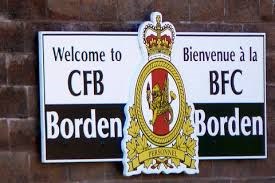You may know there is a base just south of Angus and a few kilometres north of Alliston, but many people do not know of the rich history of one of Canada’s oldest military bases.
The Tec We Gwill Women’s Institute presented a history of CFB Borden via a Zoom meeting with local historian and former high school history teacher, Kirk Winter, on Jan 24.
Base Borden was established in 1916 during the First World War. Prior to the war and subsequent military build-up, the majority of Canadian Military training was done at local armouries in cities and towns across the country.
The outbreak of war on a large scale meant the Canadian army went from a force of about 5,000 in 1914 to around 500,000 by 1916. This meant the armouries did not have the capability to train men in large numbers and the government started looking for places to build large training centres.
The location chosen to build Base Borden was dependent on several things. First of all, the land had to be inexpensive as they needed a lot of it. It also had to be near an urban area.
As far as transportation, the location had to have access to a rail line as supplies, equipment and troops at the time would all be moved via rail.
When the first soldiers arrived, they were faced with the challenge of living at a location with no buildings, no running water, and no electricity. The first soldiers spent the winter in canvas tents.
The first units, to arrive at the base were the 157th and 177th Infantry Battalions. They were part of the Canadian Expeditionary Force, meaning they weren’t training to defend the country, they were training to go to Europe and support the British Empire.
While the camp started as an infantry training base, it soon expanded as aircraft were being used for the first time in warfare, and they needed a place to train pilots.
The Royal Flying Corp, the precursor to the Royal Canadian Air Force, arrived in 1917. Base Borden became the first airbase in Canada.
Many pilots learned to fly a Sopwith Camel at the base.
There are currently five of the original aircraft hangers from the First World War that are still standing and have been restored.
They have been declared as national historic sites.
After the war, the plan was to close many bases and get back a regular peacetime situation. Borden survived the cut and, in fact, became very busy over the next 20 years.
When the Royal Canadian Air Force was established as a separate branch of the military in 1924, Base Borden became the largest “flying station” in the country as they trained pilots on the huge airfield.
Over those two decades, the Base trained infantry, the Royal Canadian Signal Corp, and even messenger pigeon handlers.
For many years, the Base operated as two camps: one run by the army and one run by the Air Force.
In the late 1930s, the Base became a major tank training base.
When the Second World War started, the Allies needed a safe place to train pilots. The British Commonwealth Air Training Program used the base as an airfield to train pilots without risk of being attacked or having aircraft go down behind enemy lines.
Between 1939 and 1945, around 130,000 flight personnel were trained in Canada.
Borden served as the main training base for flight operations.
After the Second World War, there was much talk that Base Borden was going to be closed. Several other bases were sold, however, Base Borden remained active.
Having a military base nearby is always considered a local advantage because of the economic impact they have on neighbouring cities and towns.
During the Cold War, the Base was very active. The Base hosted an underground bunker designed to be a refuge for VIPs during a nuclear attack.
Currently, the Base is home to the 400 Helicopter Squadron, the 3rd Ranger Patrol Group, and 700 Communications Squadron who do year-round training at the base.
Base Borden is home to a museum that houses a large collection of battle tanks and armoured personnel carriers.
The Base has become its own small town with many amenities available to those who live there.
Base Borden has become an integral part of the region and it’s not unusual to see a military uniform in other towns in the area.
Brian Lockhart, Local Journalism Initiative, New Tecumseth Times



